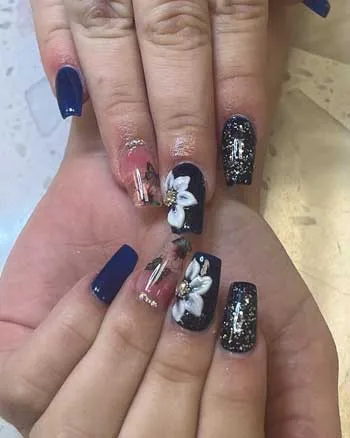Our Blog
- Articles
8 Simple Ways to Banish Dry, Brittle Nails for Good

By Robert H.
There’s a special kind of power in having healthy, strong nails, whether you work the nail colors, go polish-free, or love nude nail colors. Healthy nails (and even the results of good nail cuticle care) are one of those less-visible confidence boosters, like wearing a fancy pair of underwear just because or splurging on amazing socks to wear under your boots. Whether your nail care is a form of self-care, an indulgence, or just routine maintenance, keeping your nails in tip-top shape is a worthwhile investment. And here’s the good news: Healthy nails require an investment of time, not money.

The best route to stronger, longer nails is mostly through simple lifestyle habits, not pricy nail tools. But getting healthy nails also means kicking some bad habits, such as using your nails as a built-in pocket knife. For doable, helpful nail tips, we talked to the experts for the everyday dos and don’ts of nail care. Follow these steps, and you’ll have stronger, longer nails before you know it.
How to strengthen nails
1. Moisturize your nails
Moisturizing is a well-known secret to healthy skin, but it’s often overlooked in nail care. While dry, brittle nails can be the result of many factors, they’re ultimately a cry for moisture, so consider proper moisture the foundation of your nail care routine. When applying hand lotion, give your nails a little extra attention. There are plenty of moisturizing nail products on the market, but applying moisturizer is really only half the battle—there’s more to strong nails than a fancy cream or serum.
2. Leave your cuticles alone
It’s common practice to cut, push back, or try to get rid of cuticles altogether, but cuticles are not the enemy. In fact, the cuticle is “the nail’s natural protective seal,” according to Dana Stern, MD, a board-certified dermatologist and nail expert. Messing with your cuticles can do far more harm than good—even if a nail technician is the one doing the handiwork. Dr. Stern says a compromised cuticle can leave the nails vulnerable and at risk of infection.
Michele Green, MD, a cosmetic dermatologist, agrees that poorly kept cuticles can have a domino effect. “When your cuticles get dry or injured it can injure the nail bed and affect the way your nails grow out,” Dr. Green says. She recommends moisturizing the cuticles with cream or cuticle oil to help protect and strengthen your nails.
3. Avoid contact with water
Don’t stop washing your hands or shower with gloves on, but do pay attention to ways you can reduce the time your nails spend in contact with water, because excessive water contact can weaken nail structure. (Wet hairis especially vulnerable, and the same caution-when-wet approach you take to handling wet locks can apply to nail care, too.) For example, consider wearing gloves while doing the dishes or other wet work.
You know how soft and bendy nails get after a long bath? Consider this: “The nail is like a sponge. It is 1,000 times more absorptive of water than the skin, for example, and so water can easily diffuse into the nail,” Dr. Stern says. Excessive water exposure can put significant strain on delicate nail cells (called onychocytes), which can lead to brittleness, peeling, and breakage, she says.
This is also why soaking nails before a manicure is bad practice. Not only does this make your nails more vulnerable to infection, according to Dr. Green, but it also doesn’t allow nail polish to adhere as well or last as long.
4. Be gentle
The best nail care is gentle care, according to Susan C. Taylor, MD, board-certified dermatologist and expert in treating skin of color. For starters, Dr. Taylor advocates against invasively digging under your nails. “Sometimes people take the pointy end of a nail file and they dig underneath their nails to get the dirt out,” she says. “You don’t want to do that, because it can separate the nail plate from the underlying bed, and then you can develop a bacterial fungal infection.”
For similar reasons, you should resist the urge to use your nails as replacement tools—no matter how convenient it may be. (There are plenty of other creative ways to open a can of soda.) And if you do indulge in an acrylic or gel manicure—which you should only do sparingly—proper removal is important. “When you peel [acrylic or gel nails] off, you’re really peeling layers of the nail, the nail plate, and that’s going to weaken your nails—so that’s a no-no,” Dr. Taylor says.
5. Treat your nails like you treat your hair
It’s the new golden rule. Hair and nails are both composed of keratin proteins, so it makes sense that many of the same rules for treatment apply. Dr. Stern says both hair and nails can become dehydrated and damaged from over-processing. Frequent polish removal, gels, and acrylics do to nails what dyes, chemicals, and heat application do to hair. Just as hydration can help repair hair issues such as frizz and split ends, it can help improve dry and brittle nails. There’s no nail care equivalent to second-day hair, but operating as though there are hard and fast rules for how to wash, care for, and use your nails can help keep them in the same good shape as your hair.
It bears repeating: Hydration is the foundation. “Just as you would condition your hair with a leave-in or rich conditioner, I would condition your cuticles as well to promote healthy, growing nails,” Dr. Green says.
6. Watch the weather
Winter can be a rough time for skin, hair, and nails alike. Not only can cool, dry weather cause nails to get extra brittle, but Dr. Stern says the extreme swings in temperature from going outdoors to indoors can cause additional damage. The shift from a heated home or office to the chilly open air can cause nail cells to contract and expand repetitively, resulting in a weakening between the cells, leading to breakage, she says. It’s smart to always wear gloves in the winter and, you guessed it, moisturize, moisturize, moisturize to protect both the skin of your hands and your nails.
7. Rethink your products
Nail files: Instead of those old-as-time emery boards, which Dr. Stern says “create microscopic tears in the nail that lead to splits and peeling,” opt for a glass or crystal nail file.
Nail polish remover: In the best-case scenario, you would avoid nail polish remover altogether. But since most of us aren’t going to entirely give up the joy of a nice manicure, it’s better to instead use non-acetone removers that contain hydrating oils and ingredients.
Nail brush: Instead of digging under your nails with tools such as a filer, which Dr. Taylor warns against, use a gentle nail brush to clean out dirt. Or, for a resourceful alternative, use an extra toothbrush you have lying around.
Nail growth products: Go ahead and pass on these. “So many of the so-called nail treatment or nail growth products on the market are in reality clear nail polishes with marketing additives that have no scientific validity,” Dr. Stern says.
8. Be patient with nail growth
If you’re a chronic nail-biter, you know the victory of finally growing your nails out past your fingertips. Healthy habits plus patience pay off in nail care. But the primary focus should be on figuring out how to strengthen your nails, not solving the puzzle of how to grow nails fast. Stronger nails can lead to longer nails if you practice good nail care, but it all takes time. If you battle brittle nails and constant breakage, it’s smart to keep your nails clipped short until they regain strength; then they’ll have the foundation they need to grow longer.
Book your appointment TODAY!
Please click the button below and book us. We will get in touch with you within 1 business day.
